
Mass Effect is an action role-playing game developed by BioWare and originally released for the Xbox 360 in 2007. It is the first game in the Mass Effect series, and takes place within the Milky Way galaxy in the year 2183, where civilization is threatened by a highly advanced machine race known as the Reapers. The player assumes the role of Commander Shepard, an elite human soldier who must stop a rogue agent from carrying out the Reapers' galactic invasion. The game involves completing multiple quests that generally involve space exploration, squad and vehicular combat, and interaction with non-player characters.

The asari are a fictional extraterrestrial humanoid species in the Mass Effect multimedia franchise developed by BioWare and published by Electronic Arts. Introduced in the 2007 novel Mass Effect: Revelation, the asari are a sapient homeotherm species who are naturally inclined towards biotics, the ability to manipulate dark energy and alter the mass of objects through the use of electrical impulses from the brain, which produce various psychic abilities such as telekinesis.

The quarians are a fictional extraterrestrial humanoid species in the Mass Effect multimedia franchise developed by BioWare and published by Electronic Arts. The quarians and their backstory are introduced in the first Mass Effect through the companion character Tali'Zorah, with quarian society as a whole playing a more prominent role in its sequels.
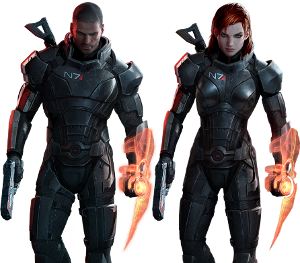
Commander Shepard is the player character in the Mass Effect video game series by BioWare.

The Reapers are a fictional fleet of sentient starships that serve as the main antagonists of the Mass Effect trilogy. The design of the Reapers was inspired by H. P. Lovecraft's Cthulhu Mythos deities. Within the series, the Reapers cause galactic-level mass extinctions every fifty-thousand years. The Reapers and their technology are capable of brainwashing organic life through a mind control process called indoctrination. The Reapers employ servants who are often altered into synthetic-organic life forms.
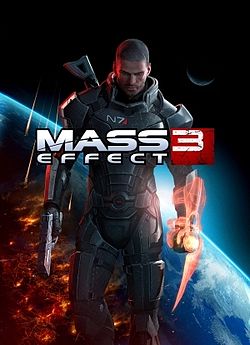
Mass Effect 3 is an action role-playing video game developed by BioWare and published by Electronic Arts. The third major entry in the Mass Effect series and the final installment of the original trilogy, it was released in March 2012 for Microsoft Windows, Xbox 360, and PlayStation 3. A Wii U version of the game, entitled Mass Effect 3: Special Edition, was later released in November 2012. The game is set within the Milky Way galaxy in 2186, where galactic civilization is invaded by a highly advanced machine race of synthetic-organic starships known as Reapers. It concludes the story of Commander Shepard, an elite human soldier who is tasked with forging alliances between species for the war.

Mass Effect Galaxy was a mobile game for iOS developed by BioWare and published by Electronic Arts. Galaxy follows former Systems Alliance soldier Jacob Taylor as he works with his colleague Miranda Lawson and other allies to foil a terrorist conspiracy against the Citadel Council, an executive committee consisting of several politically dominant species who hold great sway in the galaxy and are recognized as an authority by most of explored space. Both Jacob and Miranda would later appear as recurring characters in the science fiction action role-playing video game series Mass Effect, most notably as companion characters in Mass Effect 2, where they are revealed to be members of the anthropocentric paramilitary organization, Cerberus.
Mass Effect is a military science fiction media franchise created by Casey Hudson. The franchise depicts a distant future where humanity and several alien civilizations have colonized the galaxy using technology left behind by advanced precursor civilizations.
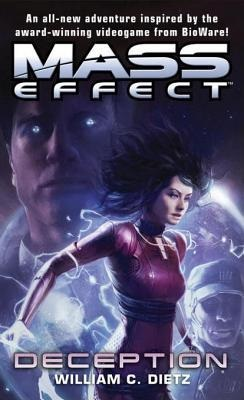
Mass Effect: Deception is a novel by writer William C. Dietz set in the Mass Effect universe. Published in 2012 by Del Rey Books, it is the fourth novel set in the Mass Effect universe, and continues the story of the previous three novels. Deception is notable for the negative reception from fans of the Mass Effect series, which prompted significant coverage from media outlets. In response to the negative reception, BioWare announced in February 2012 that they intended to revise the novel's content for future editions of Deception. No rewrite has been announced or published ever since.

The Illusive Man is a fictional character in BioWare's Mass Effect video game franchise. He is the leader of the pro-human group Cerberus. The Illusive Man wears an open suit that connotes both futuristic style and the "casual swagger of a charming billionaire". His eye implants make him appear slightly inhuman. He is normally seen in an empty office with no indication of his living arrangements. He is voiced by Martin Sheen.
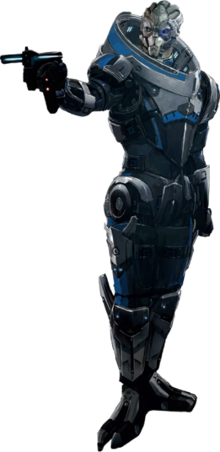
Garrus Vakarian is a fictional character in BioWare's Mass Effect franchise, who acts as a party member in each of the three games in the original trilogy. Garrus is a turian, one of the various alien species in Mass Effect, and is voiced by Brandon Keener.

Urdnot Wrex is a fictional character in BioWare's Mass Effect franchise, who serves as a party member in the first game of the Mass Effect trilogy. He is a krogan, an alien race near-sterilised by other galactic races for their violence and high population growth. Introduced as an experienced krogan mercenary, his role changes in Mass Effect 2 and Mass Effect 3 where he becomes leader of an expanding krogan clan and eventual head of state for the krogan as a whole. After over 1000 years of aimless apathy, Wrex seeks to bring back hope to his people and reverse their fate by undoing the genophage. He is voiced by Steven Barr.

Thane Krios is a fictional character in BioWare's Mass Effect franchise, who first appeared in Mass Effect 2 as a party member. The character is a drell, a race of extraterrestrial reptilian humanoids who form a sociopolitical alliance with the hanar, a sentient species of jellyfish-like entities. Thane Krios is voiced by Keythe Farley in the video game series.

Mordin Solus is a fictional character in BioWare's Mass Effect franchise, who serves as a party member in Mass Effect 2. A salarian physician and life scientist who was once a member of the salarian intelligence organization Special Tasks Group ("STG") earlier in his life, Mordin is depicted as a fast-talking and affable individual who is initially guided by scientific principles and logic, but later changes his mind and adopts strong moral standards as well as a respect for all forms of life.

The turians are a fictional extraterrestrial humanoid species in the Mass Effect multimedia franchise developed by BioWare and published by Electronic Arts. Turians are the first alien species to have come into contact with humanity within series lore, which inadvertently sparked a brief but vicious period of conflict which is eventually de-escalated due to the intervention of the Citadel Council, a multispecies governing body based on the Citadel space station. The aftermath of the so-called First Contact War as well as the underlying tensions between humanity and the turians form a recurring narrative theme in the Mass Effect series, which began with the franchise's debut work, the 2007 novel Mass Effect: Revelation. Turians are conceived as an avian humanoid species with an exoskeleton, whose biology is radically different from that of humanity and several other species, and are culturally rooted in a stratocratic society. Turian characters have appeared in most Mass Effect games and media with several playing major storyline roles, such as Garrus Vakarian, Saren Arterius, Nyreen Kandros, Vetra Nyx and Tiran Kandros. In addition, the turians are playable characters in the multiplayer modes for Mass Effect 3 and Mass Effect: Andromeda.
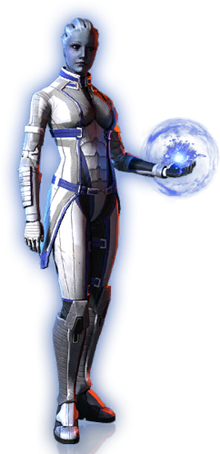
Dr. Liara T'Soni is a fictional character in BioWare's Mass Effect franchise, who serves as a party member in the original Mass Effect trilogy. She is an asari, a female-appearing species from the planet Thessia who are naturally inclined towards biotics, the ability to "manipulate dark energy and create mass effect fields through the use of electrical impulses from the brain". Within the series, Liara is noted for being the galactic scientific community's foremost expert in the field of Prothean archaeology and technology, specifically evidence concerning the demise of the ancient Protheans, believed by the galactic community to be the pre-eminent civilization in the Milky Way galaxy until their sudden disappearance fifty thousands years before the events of the first Mass Effect.

Mass Effect 3: Omega is a major downloadable content (DLC) pack developed by BioWare and published by Electronic Arts for the 2012 action role-playing video game Mass Effect 3. It was released for Microsoft Windows, PlayStation 3, and Xbox 360 on November 27, 2012, with a delayed release in Europe on the PlayStation 3 platform set for November 28, 2012. The pack follows Commander Shepard and the asari pirate queen Aria T'Loak as they attempt to liberate the space station Omega from the anthropocentric terrorist group Cerberus. Omega expanded beyond the developers' original plan during its development cycle, both in response to a mandate of freedom by BioWare management and as a result of the development team's desire to develop the experience they wanted, and incorporates cut content from the main game.
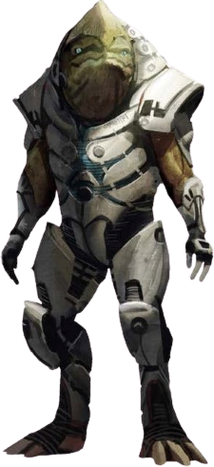
The Krogan are a fictional extraterrestrial humanoid species in the Mass Effect multimedia franchise developed by BioWare and published by Electronic Arts. A member of the species is first introduced in the 2007 novel Mass Effect: Revelation. The Krogan are typically depicted as large reptilian bipedal humanoids who are physically tenacious, favor mercenary work, and thrive on conflict and violence. The Krogan are native to the planet Tuchanka, which is presented as a post-apocalyptic wasteland as a result of the Krogan's global thermonuclear civil war in the distant past. The Krogan are presented as having a complicated relationship with the rest of the Milky Way galactic civilizations, especially the Salarians; a past conflict led to the other interstellar species unleashing a genetically engineered biological weapon called the Genophage on the Krogan, drastically reducing their population and potentially driving the species to a slow and inevitable extinction.

The Mass Effect media franchise, developed by BioWare and published by Electronic Arts, is set in the distant future where various extraterrestrial species coexist with humanity. The developers created extensive background lore for the universe of Mass Effect and its alien species, with detailed explanations documenting the complex relationships between the universe's various factions and the setting's phenomena from a scientific perspective. The developers were inspired and influenced by numerous fantasy and science fiction works, as well as real world cultural and scientific concepts. Dark energy, a form of energy theorized to massively affect the universe, forms a key part of the franchise's concept and background.

















